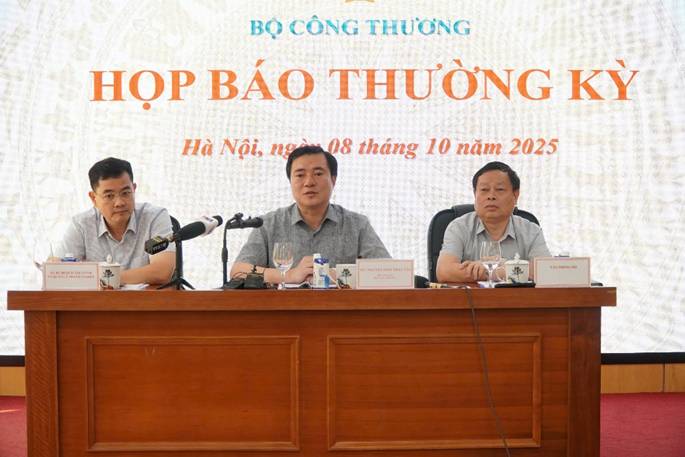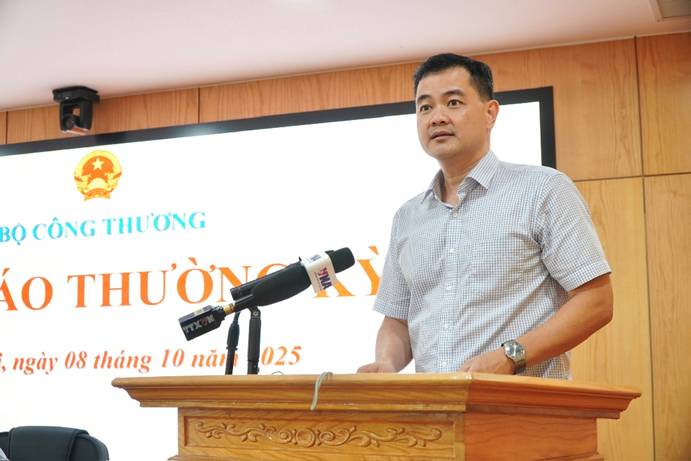Ministry of Industry and Trade holds regular press conference for Q3 2025
On the afternoon of October 8, the Ministry of Industry and Trade held its regular press conference for the third quarter of 2025 to provide information on the performance of the industrial and commercial sectors over the past nine months. The event was chaired by Deputy Minister Nguyen Sinh Nhat Tan.
The conference was attended by leaders of the Ministry’s functional units, including the Ministry Office, the Department of Planning, Finance and Enterprise Management, the Department of Foreign Market Development, the Domestic Market Department, the Trade Remedies Authority, the Import-Export Department, the National Competition Commission, the Electricity and Renewable Energy Authority, the Industry Agency and other relevant units, as well as numerous journalists and reporters from media organizations.
Opening the conference, Bui Huy Son, Director General of the Department of Planning, Finance and Enterprise Management, presented a report on the performance of the industrial and commercial sectors in the first nine months of 2025.
According to Bui Huy Son, the industry and trade sector achieved positive results during this period, contributing significantly to the country’s overall economic growth.

Deputy Minister Nguyen Sinh Nhat Tan chaired the press conference.
Regarding industrial production, companies ramped up production to boost exports ahead of the United States’ upcoming tariff increases. At the same time, mining and electricity generation activities became more robust in recent months, driving the industrial production index in the third quarter of 2025 to double-digit growth, increasing by 10.0 percent year-on-year.
Overall, the industrial production index rose by 9.1 percent in the first nine months, compared to an 8.4 percent increase in the same period last year. The manufacturing and processing industry grew by 10.4 percent, the highest rate since the beginning of the current government term.
Electricity production and distribution increased by 6.1 percent, compared to 10.8 percent last year. The water supply, waste and wastewater management sector rose by 8.8 percent, compared to 9.7 percent in the same period of 2024. The mining sector grew slightly by 0.1 percent after a 6.9 percent decline last year.
Notably, industrial growth was broad-based, with the industrial production index increasing in all 34 provinces and cities across the country compared to the same period in 2024. Several major industrial localities posted double-digit growth, including Phu Tho with 27.7 percent, Ninh Binh 22 percent, Quang Ninh 17 percent, Bac Ninh 15.7 percent, Hai Phong 15.1 percent, Thanh Hoa 15.2 percent and Nghe An 16.4 percent.
Regarding the domestic market, retail sales and consumer service revenue in the first nine months increased by 9.5 percent year-on-year, compared to 8.8 percent in the same period last year, reflecting a significant improvement in market demand, though still below the expected growth target. Goods supply remained abundant and prices stable, meeting consumer demand even in areas affected by storms. Electricity and fuel supply were secured, and market inspection and control efforts were strengthened.
Market surveillance forces carried out 17,746 inspections in the first nine months, detected and handled 15,544 violations, with administrative penalties totaling approximately USD 402 million. Nearly USD 216 million was collected for the state budget, and 133 cases showing criminal signs were transferred to investigative agencies.
E-commerce continued its strong momentum, growing by an average of 22 to 23 percent over the first nine months of 2025.
Regarding foreign trade, imports and exports remained a major highlight of the economy. Total trade turnover in the first nine months reached USD 680.6 billion, up 17.3 percent year-on-year.
Exports in the third quarter of 2025 reached USD 128.57 billion, increasing by 18.4 percent compared to the same period last year and 9.6 percent compared to the previous quarter. Total export value for the nine-month period reached USD 348.74 billion, up 16.0 percent year-on-year, exceeding the annual growth target of 12 percent. The domestic sector contributed USD 85.41 billion, up 2.0 percent, accounting for 24.5 percent of total exports, while the foreign-invested sector, including crude oil, reached USD 263.33 billion, up 21.4 percent, accounting for 75.5 percent.
There were 32 export items with values exceeding USD 1 billion, representing 93.1 percent of total exports, and 7 items exceeding USD 10 billion, accounting for 67.9 percent. The United States remained the largest export market, with USD 112.8 billion, up 27.7 percent. Exports to China reached USD 49.6 billion, up 11.3 percent; to the EU USD 41.7 billion, up 9.3 percent; to ASEAN USD 28.5 billion, up 2.9 percent; and to Japan USD 19.7 billion, up 9 percent.

Director General of the Department of Planning, Finance and Enterprise Management Bui Huy Son delivered a report on industrial production and trade performance over the first nine months of 2025.
In terms of product structure, the manufacturing and processing sector remained the main driver, with export turnover reaching USD 297.2 billion, up 16.7 percent year-on-year and accounting for 85.2 percent of total exports. Key export products such as phones, computers and components, textiles and footwear maintained their leading positions, underscoring the pivotal role of the processing industry in Vietnam’s international trade.
Agricultural exports were estimated at USD 33.2 billion, up 15.2 percent, representing 9.5 percent of total export value.
Imports in the third quarter reached USD 119.66 billion, up 20.2 percent year-on-year and 6.3 percent compared to the previous quarter. Total imports in the first nine months amounted to nearly USD 332 billion, up 18.8 percent. The domestic sector imported USD 105.67 billion, up 4.6 percent, while the foreign-invested sector imported USD 226.25 billion, up 26.8 percent.
China remained Vietnam’s largest import market with USD 134.4 billion, up 27.9 percent, followed by the RoK with USD 44.4 billion, up 7 percent; ASEAN USD 39.1 billion, up 14.5 percent; Japan USD 18.2 billion, up 13.2 percent; and the United States USD 13.7 billion, up 23.6 percent.
Essential imports accounted for 89 percent of total import value, rising by 19.5 percent, reflecting strong demand for inputs such as raw materials and machinery to support domestic production. Imports under control represented 5.2 percent, and other goods accounted for 5.3 percent.
Import growth of 18.8 percent outpaced export growth of 16 percent, signaling strong domestic production recovery but also adding some pressure to the trade balance.
The trade balance maintained a surplus of USD 16.8 billion, contributing to macroeconomic stability and foreign reserves. The domestic sector recorded a trade deficit of USD 20.26 billion, while the foreign-invested sector, including crude oil, posted a trade surplus of USD 37.08 billion.
If current conditions remain stable, the industry and trade sector is on track to meet its 2025 targets, with total trade turnover expected to reach approximately USD 900 billion by year-end.
Despite the positive results of the third quarter and the first nine months, several potential challenges remain. These include US retaliatory tariffs, temporary suspensions of Vietnamese rice imports by some key markets, and new US tariffs on wood products starting October 14, 2025, such as 10 percent on softwood and sawn wood, and 25 percent on kitchen cabinets, bathroom cabinets and upholstered wooden furniture. From January 1, 2026, tariffs will increase to 30 percent on upholstered furniture and 50 percent on kitchen and bathroom cabinets, which may affect Vietnam’s wood product exports.
To achieve the 2025 plan, the Ministry will focus on key tasks and solutions for the remaining months, including implementing major government resolutions to support growth; improving legal frameworks to unlock resources; strengthening the domestic market and consumer protection; promoting exports through market diversification, new trade negotiations with Mercosur, GCC, Pakistan and EFTA; supporting domestic enterprises; enhancing trade promotion and origin management; and advancing decentralization and local governance reforms in industry and trade.
At the press conference, Deputy Minister Nguyen Sinh Nhat Tan, the Ministry’s spokesperson, along with representatives of relevant departments, responded to media questions on issues such as Resolution 70 on energy security, progress in US trade negotiations, livestream e-commerce, import-export activities, industry and energy.



